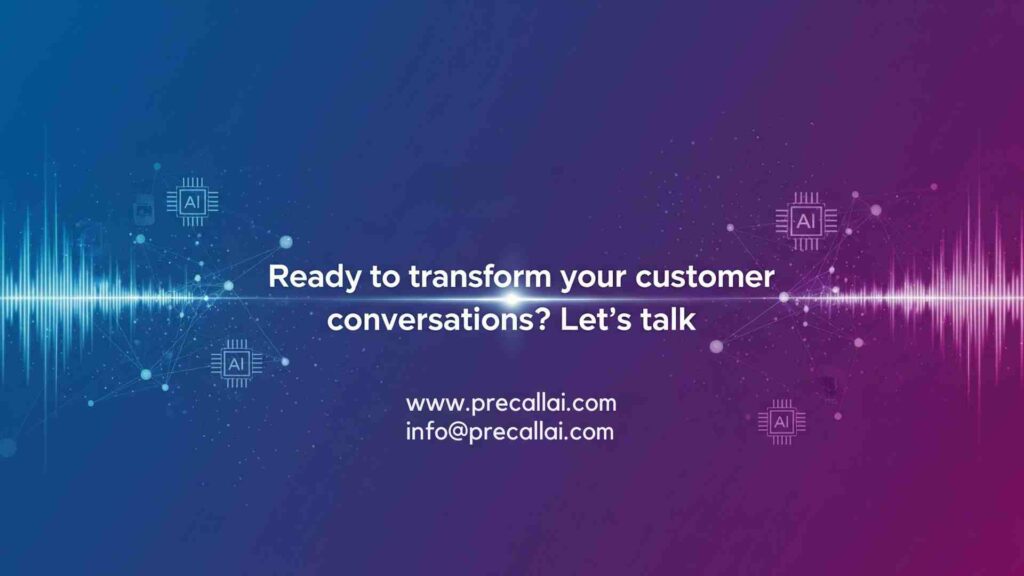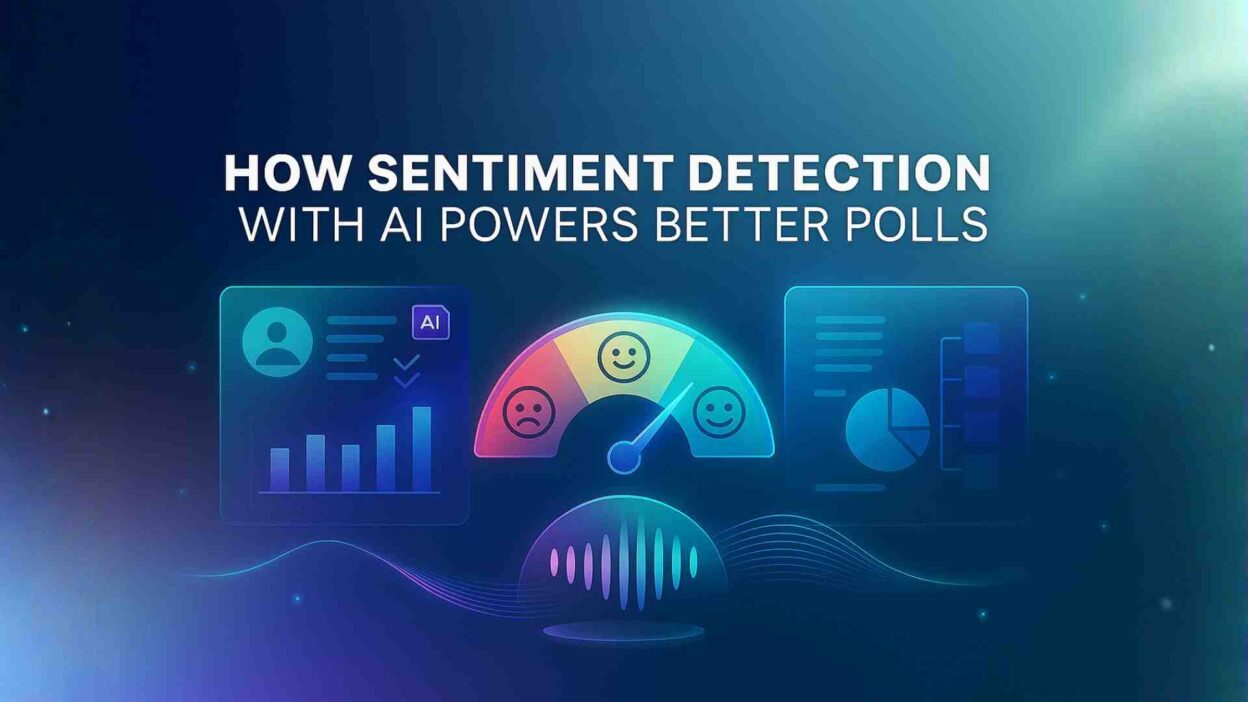TL;DR The polling industry is experiencing a massive transformation. Traditional methods are becoming outdated. AI for opinion polls and sentiment detection is changing everything we know about gathering public opinion. Organizations can now understand what people truly think and feel.
Table of Contents
Surveys used to rely on simple yes-no questions. Those days are gone. Modern technology digs deeper into human emotions. Companies want more than surface-level answers. They need authentic insights that reveal genuine attitudes.
Artificial intelligence brings precision to opinion research. Machine learning algorithms can analyze thousands of responses in seconds. This technology identifies patterns humans might miss. Businesses make smarter decisions based on accurate emotional data.
Understanding Sentiment Detection in Modern Polling
Sentiment analysis examines the emotional tone behind words. This process goes beyond counting positive or negative responses. AI systems evaluate context, sarcasm, and nuanced expressions. The technology reads between the lines of human communication.
Natural language processing forms the backbone of this innovation. Computers learn to interpret human language like never before. They recognize subtle differences in phrasing and word choice. Each response gets categorized based on emotional intensity.
AI for opinion polls and sentiment detection processes data at unprecedented speeds. Manual analysis would take weeks or months. Automated systems complete the same work in hours. Speed matters when organizations need real-time insights.
How Traditional Polls Fall Short
Old polling methods have significant limitations. Phone surveys reach fewer people every year. Response rates continue declining across demographics. Young adults rarely answer unknown numbers.
Paper questionnaires feel outdated in our digital age. Mail surveys take too long to collect and process. Data entry introduces human errors into the results. These methods cannot capture real-time sentiment shifts.
Face-to-face interviews cost enormous amounts of money. Training interviewers requires substantial resources. Geographic limitations restrict sample diversity. Bias creeps in through interviewer interactions.
The Evolution of Opinion Research
Digital platforms opened new doors for researchers. Online surveys became popular in the early 2000s. Social media added another layer of data collection. People share opinions freely on various platforms.
Text analytics emerged as a powerful tool. Researchers could finally analyze open-ended responses efficiently. Early systems used simple keyword matching. These primitive methods missed contextual meanings.
Machine learning changed the game completely. Algorithms learned from millions of text examples. Pattern recognition became increasingly sophisticated. Accuracy improved with each iteration of technology.
The Technology Behind AI Sentiment Analysis
Neural networks power modern sentiment detection systems. These artificial brains mimic human cognitive processes. Layers of computational nodes process information sequentially. Each layer extracts different features from text data.
Deep learning models require massive training datasets. Engineers feed them millions of labeled examples. The system learns to associate words with emotions. Context windows help AI understand surrounding phrases.
AI for opinion polls and sentiment detection uses multiple techniques simultaneously. Lexicon-based approaches maintain dictionaries of emotional words. Statistical methods identify patterns across large datasets. Hybrid systems combine both approaches for better accuracy.
Natural Language Processing Fundamentals
NLP enables computers to understand human language. Tokenization breaks text into individual words or phrases. Part-of-speech tagging identifies nouns, verbs, and adjectives. These steps prepare text for deeper analysis.
Named entity recognition finds important subjects in text. The system identifies people, places, and organizations. Dependency parsing reveals relationships between words. Sentence structure provides crucial context for meaning.
Semantic analysis uncovers the actual meaning behind words. Homonyms and synonyms get properly interpreted. Cultural references and idioms receive special handling. Context determines how ambiguous phrases get classified.
Machine Learning Models in Action
Supervised learning requires labeled training data. Human annotators mark thousands of text samples. The model learns patterns that indicate different sentiments. Accuracy improves as training data increases.
Unsupervised learning discovers patterns without labels. Clustering algorithms group similar responses. Topic modeling identifies recurring themes automatically. These methods uncover hidden insights in data.
Transfer learning leverages pre-trained language models. Systems like BERT and GPT understand language fundamentally. Fine-tuning adapts them to specific polling contexts. This approach requires less training data than starting from scratch.
Real-World Applications in Opinion Polling
Political campaigns rely heavily on sentiment analysis. AI for opinion polls and sentiment detection reveals voter attitudes instantly. Campaign managers adjust messaging based on emotional responses. Real-time data helps candidates connect with constituents.
Market research firms use AI to gauge consumer opinions. Product launches benefit from sentiment tracking. Companies identify potential issues before they escalate. Customer satisfaction improves through proactive adjustments.
Brand monitoring has become essential for businesses. Social media mentions get analyzed for emotional content. Negative sentiment triggers immediate response protocols. Positive feedback gets amplified through marketing channels.
Political Campaign Optimization
Election polls need accurate sentiment measurement. Voters express complex feelings about candidates. Simple favorability ratings miss important nuances. Emotional analysis reveals why people support or oppose politicians.
Focus groups cost thousands of dollars per session. AI analyzes millions of social media posts for free. Geographic sentiment mapping shows regional differences. Campaigns allocate resources to areas needing attention.
Debate performance gets measured through real-time sentiment. Viewer reactions flow in through social platforms. Speechwriters adjust future messaging based on responses. This feedback loop creates more resonant communication.
Consumer Behavior Insights
Product reviews contain valuable emotional information. Star ratings alone don’t explain customer feelings. AI for opinion polls and sentiment detection extracts specific pain points. Companies fix problems that actually matter to buyers.
Customer service interactions generate massive text data. Support tickets reveal frustration patterns. Sentiment trends identify systemic issues. Organizations improve processes based on emotional feedback.
Purchase intent gets predicted through sentiment analysis. Positive emotions correlate with buying behavior. Marketing teams target high-sentiment segments. Conversion rates improve through better audience understanding.
Social Listening and Brand Health
Companies monitor online conversations continuously. Brand mentions appear across countless platforms. Manual monitoring misses the most relevant discussions. AI tracks everything related to brand perception.
Crisis detection happens in real-time now. Sudden negative sentiment spikes trigger alerts. PR teams respond before situations spiral. Reputation damage gets minimized through quick action.
Competitor analysis benefits from sentiment comparison. Brands benchmark their emotional ratings against rivals. Strategic advantages emerge from perception gaps. Marketing strategies adapt to competitive landscapes.
Benefits of AI-Powered Sentiment Detection
Accuracy reaches levels impossible with manual analysis. Human readers bring personal biases to interpretation. AI systems apply consistent standards across all data. Reliability improves dramatically with automated processing.
Scale becomes virtually unlimited with AI tools. Thousands of responses get analyzed simultaneously. Geographic boundaries disappear completely. Global opinion research happens affordably.
Speed transforms how organizations make decisions. AI for opinion polls and sentiment detection provides instant results. Leadership teams access current data during meetings. Strategic pivots happen before opportunities disappear.
Cost Efficiency and Resource Optimization
Traditional polling requires large human teams. Interviewers, data entry clerks, and analysts cost money. AI systems run with minimal human oversight. Operational expenses drop significantly.
Sample sizes can increase without proportional cost increases. More data points improve statistical validity. Confidence intervals narrow with larger samples. Results become more representative of populations.
Continuous monitoring replaces periodic surveys. Organizations track sentiment changes constantly. Trend analysis reveals patterns over time. Predictive models forecast future sentiment shifts.
Enhanced Data Quality
Respondent fatigue affects traditional survey quality. Long questionnaires produce thoughtless answers. Open-ended responses get skipped frequently. AI analyzes naturally occurring text instead.
Social desirability bias disappears with AI analysis. People express genuine opinions online freely. Anonymous platforms encourage honest feedback. Authentic sentiment emerges from unstructured data.
Sampling errors decrease with larger datasets. AI processes millions of data points easily. Representative samples become easier to achieve. Statistical significance improves across demographics.
Real-Time Insights and Agility
Market conditions change rapidly in modern business. Yesterday’s data becomes obsolete quickly. AI for opinion polls and sentiment detection tracks sentiment minute-by-minute. Organizations adapt strategies immediately.
Event-driven sentiment analysis measures reactions instantly. Product launches generate immediate feedback. Marketing campaigns get evaluated in real-time. Course corrections happen before resources get wasted.
Competitive intelligence becomes more actionable. Sentiment shifts signal market opportunities. First-movers gain advantages over slower competitors. Agile organizations outperform traditional ones.
Implementation Strategies for Organizations
Starting with clear objectives is essential. Define what sentiment data will accomplish. Identify specific business questions needing answers. Goals guide technology selection and implementation.
Data infrastructure requires careful planning. Existing systems must integrate with new tools. APIs connect various data sources seamlessly. Security protocols protect sensitive information.
Choosing the right AI platform matters significantly. AI for opinion polls and sentiment detection solutions varies widely. Some specialize in social media analysis. Others focus on survey responses.
Selecting the Right Tools and Platforms
Cloud-based solutions offer quick deployment. SaaS platforms require minimal IT resources. Scalability comes built into pricing models. Updates happen automatically without downtime.
Enterprise solutions provide customization options. On-premise deployment suits security-conscious organizations. Integration capabilities connect with existing workflows. Custom models train on proprietary data.
Industry-specific tools understand domain language. Healthcare sentiment differs from retail sentiment. Financial services have unique terminology. Specialized systems perform better in context.
Building Internal Capabilities
Team training ensures successful adoption. Employees need to understand AI capabilities. Data literacy becomes a core competency. Interpretation skills matter as much as technology.
Data scientists design and tune models. They select appropriate algorithms for each use case. Model validation ensures accuracy meets standards. Continuous improvement keeps systems current.
Business analysts translate insights into action. They connect sentiment data with strategic goals. Reporting frameworks communicate findings effectively. Stakeholder buy-in depends on clear communication.
Ethical Considerations and Privacy
Personal data requires responsible handling. Privacy regulations vary across jurisdictions. GDPR and CCPA compliance is mandatory. Consent mechanisms must be transparent.
Bias in AI models can perpetuate unfairness. Training data quality determines output quality. Diverse datasets prevent discriminatory outcomes. Regular audits identify problematic patterns.
Transparency builds trust with stakeholders. Organizations should explain AI methodologies. Black-box algorithms raise ethical concerns. Interpretable models help justify decisions.
Overcoming Challenges in Sentiment Analysis
Language complexity poses significant obstacles. Sarcasm detection remains difficult for machines. Cultural context affects meaning substantially. Idioms and colloquialisms require special handling.
Multilingual sentiment analysis adds another layer. Different languages express emotions differently. Translation loses nuanced meanings. Native language models perform better than translated ones.
AI for opinion polls and sentiment detection improves constantly. Accuracy rates exceed 80% in many applications. Perfect precision remains elusive currently. Human oversight still adds value.
Handling Ambiguity and Context
Neutral statements often contain hidden sentiment. Context determines emotional valence. Previous statements influence current meaning. Conversation history provides important clues.
Mixed sentiment occurs frequently in real responses. Single comments contain both positive and negative elements. Aspect-based analysis separates different dimensions. Products have multiple features that people evaluate differently.
Irony and sarcasm flip apparent meanings. Detecting these requires a sophisticated understanding. Punctuation and emojis provide helpful signals. Advanced models learn these patterns over time.
Data Quality and Preprocessing
Noisy data degrades analysis quality. Social media contains spelling errors and abbreviations. Slang evolves faster than training datasets. Cleaning processes standardize text inputs.
Bot-generated content pollutes datasets. Fake accounts spread misinformation deliberately. Spam detection filters remove artificial responses. Authentic human sentiment is what matters.
Imbalanced datasets skew model performance. Negative comments often outnumber positive ones. Resampling techniques balance training data. Model performance improves across all sentiment categories.
Continuous Model Improvement
Language evolves constantly over time. New words and phrases emerge regularly. Yesterday’s slang becomes tomorrow’s standard vocabulary. Models need regular retraining.
Performance monitoring identifies accuracy degradation. Regular validation against new data is essential. A/B testing compares different model versions. The best-performing systems get deployed.
Feedback loops incorporate human corrections. Analysts review uncertain classifications manually. These corrections become new training examples. Models learn from their mistakes continuously.
The Future of AI in Opinion Research
Emotion recognition will expand beyond text. Facial expression analysis adds visual sentiment data. Voice tone analysis captures audio emotions. Multimodal systems combine all channels.
Predictive sentiment modeling forecasts future opinions. Historical patterns reveal likely trajectories. Early warning systems prevent negative shifts. Organizations act proactively rather than reactively.
AI for opinion polls and sentiment detection will become ubiquitous. Every customer interaction generates usable data. Opinion research happens continuously everywhere. The distinction between surveys and conversations blurs.
Emerging Technologies and Trends
Quantum computing promises exponential speed increases. Complex sentiment models will run faster. Real-time analysis of massive datasets becomes trivial. Processing power limitations disappear gradually.
Federated learning protects privacy while improving models. Data stays on local devices securely. Models train across distributed networks. Privacy and performance no longer conflict.
Explainable AI makes systems more trustworthy. Decision transparency builds stakeholder confidence. Regulatory compliance becomes easier. Organizations understand why models reach conclusions.
Integration with Business Intelligence
Sentiment data enriches traditional analytics. Financial metrics gain emotional context. Customer lifetime value predictions improve accuracy. Churn prevention targets emotionally at-risk customers.
Dashboard integration brings sentiment to decision-makers. Real-time visualizations display emotional trends. Alerts notify stakeholders of significant changes. Data-driven cultures thrive with accessible insights.
Automated reporting generates actionable recommendations. AI doesn’t just analyze sentiment anymore. Systems suggest specific responses to findings. Strategic guidance emerges from pattern recognition.
Frequently Asked Questions
How accurate is AI sentiment detection compared to human analysis?
Modern AI systems achieve 80-85% accuracy in sentiment classification. Human analysts typically reach 75-80% agreement among themselves. Context-dependent situations challenge both humans and machines. AI excels at processing volume while humans handle nuance better.
What types of data can AI sentiment analysis process?
Text from surveys, social media, reviews, and customer service tickets work well. Email content and chat transcripts provide valuable sentiment data. Audio transcriptions from calls capture spoken sentiment. Video content analysis will add facial expression data soon.
How much does implementing AI sentiment detection cost?
Cloud-based platforms start around $500 monthly for small businesses. Enterprise solutions range from $10,000 to $100,000 annually. Custom development projects cost $50,000 to $500,000, depending on complexity. ROI typically appears within six months of deployment.
Can sentiment analysis work in multiple languages?
Yes, but accuracy varies by language. English models have the most training data available. Major languages like Spanish, Chinese, and Arabic perform well. Rare languages and dialects present ongoing challenges. Multilingual models improve continuously.
How do you measure the effectiveness of sentiment analysis?
Accuracy, precision, and recall metrics quantify performance. Confusion matrices show where misclassifications occur. Business outcome improvements validate practical effectiveness. Customer satisfaction scores correlate with sentiment trends.
What industries benefit most from AI-powered sentiment analysis?
Retail and e-commerce gain immediate customer feedback insights. Financial services monitor market sentiment and client satisfaction. Healthcare tracks patient experience and treatment satisfaction. Political organizations optimize campaign messaging effectively. AI for opinion polls and sentiment detection helps every industry that values customer opinions.
Read More: How Quickly Can Enterprises Deploy AI Voice Technology?
Conclusion

The polling landscape has transformed dramatically. AI for opinion polls and sentiment detection delivers insights impossible just years ago. Organizations understand their audiences at unprecedented depths. Decision-making improves when emotional data guides strategy.
Technology continues to advance at a remarkable speed. Accuracy improves with each algorithmic breakthrough. Costs decrease as solutions become commoditized. Accessibility expands to organizations of all sizes.
Traditional polling methods cannot compete anymore. Speed and scale favor automated systems overwhelmingly. Human expertise still matters for interpretation. The future belongs to human-AI collaboration.
Sentiment detection has moved beyond experimental status. Proven results demonstrate clear business value. Investment in AI capabilities pays dividends quickly. Forward-thinking organizations are already benefiting.
Understanding public opinion matters more than ever. Markets move faster in our connected world. Social media amplifies voices instantaneously. Organizations need real-time emotional intelligence.
AI provides that intelligence affordably and accurately. Implementation challenges can be managed with proper planning. The learning curve is shorter than most assume. Benefits appear quickly after deployment.
The future of opinion research is here. Artificial intelligence makes better polls possible. Organizations that adapt will thrive. Those who don’t will struggle to compete.





